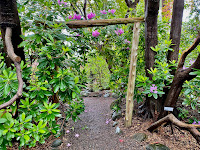Located along the coast of southern New Hampshire, Fuller Gardens was part of the estate of Alvan T. Fuller, one of the first businessmen to create an automobile dealership in Boston, and former Governor of Massachusetts. Mr. Fuller commissioned the gardens in the late 1920s and following his death in 1958, the gardens were opened to the public.
Website: https://fullergardens.org/
It was difficult to locate any publicly accessible information specific to the Japanese garden. However, it appears to have been part of the original design first established in 1927 rather than a later renovated design during the 1930s.
One indication of its early development was the very large Cedar shrubs that enclosed the Japanese garden and separated it from the other gardens on site.
Once inside, there are features that align well with an "Orientalist" style garden from the late 19th - early 20th century.
Overall, The Fuller Garden Japanese garden is a small, but historically significant example of a Japanese garden from a period of time when Japanese gardens were first becoming popular in the United States. The grounds director and his staff should be commended for maintaining a garden that has evolved over time, is located in a challenging location with extreme weather conditions along the shore, and continues to reflect the historic significance of its original design.

















